
94% of researchers rate our articles as excellent or good
Learn more about the work of our research integrity team to safeguard the quality of each article we publish.
Find out more
ORIGINAL RESEARCH article
Front. Signal Process., 11 February 2022
Sec. Signal Processing for Communications
Volume 1 - 2021 | https://doi.org/10.3389/frsip.2021.820617
This article is part of the Research TopicWomen in Signal ProcessingView all 12 articles
In this paper, we consider the beamspace ESPRIT algorithm for Millimeter-Wave (mmWave) channel sensing. We provide a non-asymptotic analysis of the beamspace ESPRIT algorithm. We derive a deterministic upper bound for the matching distance error between the true angle of arrival (AoA) of the channel paths and the estimated AoA considering a bounded noise model. Additionally, we leverage the insight obtained from our theoretical analysis to propose a novel max-min criterion for beamformer design which can enhance the performance of mmWave channel estimation algorithms, including beamspace ESPRIT. We consider a family of multi-resolution beamformers which can be implemented using phase shifters and introduce a design scheme for the optimal beamformers from this family with respect to the proposed max-min criteria. We can guarantee a minimum beamforming gain uniformly over a region of possible multipath directions, which can lead to more robust channel estimation. We provide several numerical experiments to verify our theoretical claims and demonstrate the superior performance of the proposed beamformers compared to existing beamformer design criteria.
Millimeter wave (mmWave) communication has emerged as a key technology for the next generation of wireless communication systems due to an abundance of spectrum availability in the mmWave bands, and the higher data rates enabled by larger bandwidths (Bai and Heath, 2014).1 However, at mmWave frequencies, the wireless channel is spatially sparse and suffers from severe path loss. To ensure reliable communication, it becomes essential to perform beamforming in order to combat this path loss. Due to the large number of antennas in a mmWave system, it is impractical to implement a fully digital beamforming scheme with a dedicated radio frequency (RF) chain for every antenna, which would incur high power consumption and cost. In order to overcome this challenge, mmWave systems typically utilize either analog (Junyi Wang et al., 2009; Hur et al., 2013) or hybrid beamforming approaches with a reduced number of RF chains (Alkhateeb et al., 2014a; Han et al., 2015). Therefore, the problem of mmWave channel estimation becomes challenging, since a high-dimensional channel matrix (whose size is given by the large number of antennas) needs to be estimated from only low-dimensional measurements acquired at the output of a reduced number of RF chains, especially with limited pilot overhead.
MmWave channel sensing has emerged as an active area of research, with many algorithms having been developed for both flat-fading (Alkhateeb et al., 2014b; Bogale et al., 2015; Lee et al., 2016; Méndez-Rial et al., 2016) and frequency-selective channels (Alkhateeb and Heath, 2016; Gao et al., 2016; González-Coma et al., 2018; Rodríguez-Fernández et al., 2018). Under the flat-fading model, compressed sensing based techniques that leverage the sparse nature of the channel, have been proposed (Park and Heath, 2018). Recently, adaptive schemes have also been developed for estimating the channel paths by employing hierarchical multi-resolution beamforming codebooks (Alkhateeb et al., 2014b). However, such techniques assume the multipath angles to be on a grid, which can potentially introduce bias (grid-offset). The mmWave channel model shares many similarities with the measurement models arising in array signal processing, which enables the application of super-resolution AOA estimation techniques such as multiple signal classification (MUSIC) and estimating signal parameters via rotational invariance techniques (ESPRIT) for mmWave channel estimation (Schmidt, 1986; Roy and Kailath, 1989). Suitable variants of these algorithms have been developed in the beamspace which leverage the structure of beamformers to enable super-resolution estimation of the AOAs (Guanghan Xu et al., 1994; Zoltowski et al., 1996; Li et al., 2020; Sarangi et al., 2020). Finally, both sparsity-based techniques (Gao et al., 2016; Park and Heath, 2018; Rodríguez-Fernández et al., 2018) and subspace based angular estimation algorithms (Guo et al., 2017; Liao et al., 2017; Zhang and Haardt, 2017; Park et al., 2019; Zhang et al., 2021) have been extended for frequency-selective channels.
In this work, we focus on the ESPRIT algorithm for channel estimation (Liao et al., 2017; Zhang and Haardt, 2017; Wen et al., 2018; Rakhimov et al., 2019; Ma et al., 2020; Zhang et al., 2021). In recent times, several works (Zhang and Haardt, 2017; Rakhimov et al., 2019; Zhang et al., 2021) have considered DFT-based beamspace ESPRIT, inspired by earlier works in array processing (Guanghan Xu et al., 1994; Haardt and Nossek, 1995; Mathews et al., 1996; Zoltowski et al., 1996). However, the large number of antennas in mmWave systems lead to very narrow DFT beams (Ma et al., 2020). To get a wide spatial coverage, a large number of RF chains are required, which may not be practical. A different beamspace ESPRIT is proposed in (Liao et al., 2017) where beamformers are designed to ensure that the low-dimensional beamspace measurements share the same shift-invariance structure as the high dimensional channel. However, in order to realize this, approximately half of the antennas need to be turned off. This strategy may suffer from a reduction in total transmitted power, and inability to perform high-resolution channel estimation (Ma et al., 2020). Recently in (Ma et al., 2020), Li et al. proposed a beamspace ESPRIT scheme which is applicable for any choice of beamformer, that satisfies some mild rank constraints. Unlike the aforementioned variants of ESPRIT, only one antenna needs to be turned off at a time, which results in a negligible drop in transmitted power and signal coverage.
Despite their wide use in mmWave channel sensing, a rigorous non-asymptotic analysis for beamspace ESPRIT is currently not available. Existing performance analysis are either asymptotic in the number of snapshots (Guanghan Xu et al., 1994; Mathews et al., 1996), or based on perturbation analysis where certain higher-order terms are ignored (Roemer et al., 2014; Steinwandt et al., 2017). Recently, in (Li et al., 2020) the authors provided a rigorous theoretical analysis of the single-snapshot antenna space ESPRIT algorithm. In this work, we will extend their analysis to multi-snapshot beamspace ESPRIT. Beyond mathematical interest, a key motivation for such analysis is to develop insights on how the choice of beamformer controls the error bound. The choice of the analog/hybrid beamformer indeed determines the quality of channel estimation. Therefore, an important consideration for beamspace algorithms involves developing suitable analog/hybrid beamforming schemes that ensure reliable channel estimation. It should be noted that typically beamformer design is performed after the channel state information is available. However, while performing channel estimation using beamspace algorithms, the channel information is not available apriori and the beamformer must be designed to ensure robust performance uniformly across a variety of channel configurations.
DFT beamformers are a common choice for analog beamforming since they automatically satisfy the constant modulus constraint, and are easy to implement using purely RF (Analog) components (Méndez-Rial et al., 2016). However, the spatial coverage obtained using DFT beamformers is limited, especially with few RF chains (Li et al., 2020). Several alternate beamformer designs have been proposed that aim to approximately ensure constant gain across a sector of interest. Approximating ideal filters using only phase shifters or hybrid architectures results in optimization problems with non-convex constraints. A variety of heuristics/iterative techniques have been proposed to solve these problems, using Orthogonal matching pursuit (OMP) (Venugopal et al., 2017), alternating minimization (Yu et al., 2016), fast search-based techniques (Chen and Qi, 2018). An outstanding limitation of these techniques is that they cannot provide guarantees on the worst-case beamforming gain over the sector of interest that is finally achieved by the design. In particular, the gain at several points in the region of interest can significantly drop below the desired level. This can degrade the performance of channel estimation algorithms for several channel realizations. In this paper, we will develop beamformer designs based on alternative criteria to overcome this drawback.
Our contributions are twofold (i) non-asymptotic analysis of the beamspace ESPRIT algorithm, and (ii) design of beamformers that can enhance the performance of mmWave channel estimation algorithms (including beamspace ESPRIT). We first provide a non-asymptotic analysis of beamspace ESPRIT algorithm in (Ma et al., 2020), tailored to the flat-fading channel model. Inspired by the analysis of Single Snapshot element-space ESPRIT in (Li et al., 2020), we obtain error bounds on the matching distance error between the true angle of arrival (AoA) of the channel paths and the estimated AoA. Our error analysis is non-asymptotic in the number of snapshots, does not require any statistical assumption on the noise distributions, and the error bounds are applicable for any beamformer satisfying suitable rank constraints. Furthermore, the analysis reveals that the error bounds are controlled by the smallest singular value of a suitable matrix which is shaped by the beamformer and the AoAs. We leverage this insight from our theoretical analysis to propose a novel max-min criterion for beamforming, with the goal of boosting the performance of beamspace ESPRIT. We consider a family of multi-resolution beamformers, that exploits the geometric coupling between the antenna array manifold and the beamformer. Our design can guarantee a minimum beamforming gain uniformly over a region of possible multipath directions and can be implemented with phase shifters (analog-only implementation).
We consider a single user mmWave uplink system consisting of a single-antenna Mobile Station (MS), and a Base Station (BS) equipped with M > 1 antennas. We assume that the BS antennas are arranged in the form of a large Uniform Linear Array (ULA) with an inter-antenna spacing of λ/2, where λ denotes the carrier wavelength. It is well-known that mmWave channels exhibit sparse scattering, where each scatterer is often assumed to contribute to a single channel path (Raghavan and Sayeed, 2010; Ayach et al., 2014; Alkhateeb et al., 2014b). Based on this geometric model (Alkhateeb et al., 2014a; Alkhateeb et al., 2014b; Park and Heath, 2018), we consider a channel with S scattering paths, with θs ∈ [0, π] denoting the angle of arrival (AoA) of the sth path between the BS and the MS. Assuming that the AoAs remain unchanged during the training period, the uplink channel at the tth snapshot is given by (Park and Heath, 2018)
Here T denotes the number of time snapshots in the training period, and xs,t represents the (time-varying) gain of the sth path. The array response vector (or steering vector) associated with the sth channel path is given by
where fs≔ sin (θs) denotes the spatial frequency determined by the AoA θs. Notice that, Eq. 1 corresponds to a flat-fading channel model, which is of interest in this paper.2 We further consider a low-mobility scenario where the AoA’s do not change over the training period T (although the path gains can change).
Let
Here st represents the (known) transmitted pilot signal,3
In mmWave systems, the number of deployed antennas is very large, and a dedicated RF chain for every antenna significantly increases the hardware complexity and power consumption. Therefore, in order to reduce the number of RF chains, the signals received at the antennas are linearly combined in the analog domain using a network of analog beamformers, where the number of beamformers is given by the number of RF chains. Due to a limited number of RF chains, the measurement at the output of the RF chains is a low-dimensional projection of the signal received at the antennas. In this work, we assume that the BS is equipped with N < M RF chains. Let
Denoting
where X = [x1, … , xT], N = [n1, … , nT]. Given
In recent times, there has been a renewed interest in utilizing classical subspace-based techniques from array signal processing for mmWave channel estimation, due to similarities between the two measurement models at mmWave frequencies (Guo et al., 2017; Liao et al., 2017; Zhang and Haardt, 2017; Ma et al., 2020). An obvious advantage of these subspace-based algorithms is that they enable “gridless super-resolution” estimation of the AoAs that grid-based sparse techniques fail to achieve. Specifically, variants of subspace algorithms in the beamspace have been proposed that can produce high-resolution estimates of channel parameters even with a limited number of RF chains. In (Ma et al., 2020), Li et al. proposed a beamspace ESPRIT scheme which is applicable for any choice of beamformer, that satisfies some mild rank constraints. This approach requires only one antenna to be turned off at a time, and has several advantages such as a negligible drop in transmitted power and spatial coverage.
In this paper, we will analyze this variant of the beamspace ESPRIT algorithm. For ease of exposition, we will consider a flat-fading single carrier system, although extensions are possible. Our analysis will not require any specific assumptions on the distribution of noise, other than assuming it to be bounded. Unlike the prior asymptotic analysis in (Guanghan Xu et al., 1994; Mathews et al., 1996), we will not assume a large number of snapshots, or ignore higher-order perturbation terms (Roemer et al., 2014; Steinwandt et al., 2017). We first review the algorithm from (Ma et al., 2020) in the noiseless setting adapted to the flat-fading scenario.
The key idea behind the ESPRIT algorithm is exploiting the so-called shit invariance property, which refers to arrays with two identical subarrays that are separated by a common displacement. Let
where
A necessary condition for Eq. 6 is N ≥ S. Let
Define
where
Note that under the assumption Eq. 6, we have rank(B) = S. We further assume that X has full row rank which together with rank(B) = S implies that
Let U1, and U2 be two submatrices of Uy, comprising of its first and last N rows, respectively. Then,
Notice that
where arg(λ) ∈ [−π, π) denotes the phase of the complex number λ.
The noiseless beamspace ESPRIT described above can be directly extended to a noisy setting. Consider the following noisy version of the measurement model introduced in Eq. 7:
where
We will analyze the performance of the noisy beamspace ESPRIT algorithm. Our analysis extends the recent results from (Li et al., 2020) (for single-snapshot ESPRIT), to beamspace and multi-snapshot scenarios. Our error bounds will explicitly capture the role of the beamforming matrix W, and provide insights into how the error is shaped by the interaction between the AOA (
We first define some key quantities and metrics. The wrap around distance between two spatial frequencies fi, fj ∈ [0, 1] over the unit interval is defined as:
Our error metric will be the “matching distance” between the estimated
where ψ is taken over all permutations of {1, 2, … , S}. Matching distance between the eigenvalues of
We will use the notation σk(Q) to denote the kth largest singular value of a matrix Q.
The following theorem provides an upper bound on the matching distance error between the true AoAs
Theorem 1. Consider the noisy measurement model Eq. 14. Let
then the matching distance error between
Here C is a universal constant, and
Proof. The proof follows by combining Lemma 6 and 8 of Appendix. See Supplementary Appendix for the details.
Remark 1. When S = 1, the bound Eq. 18 can be simplified to
where C′ is a constant. The quantity ‖WHa (f1)‖2 controls the error bound and represents the beamformer response to the spatial frequency f1 (direction θ1). Note that a simple scaling of the beamforming matrix W cannot improve performance since it boosts both the noise and signal components. For N = 1, ‖WHa (f1)‖2 = |wHa (f1)| represents the beamforming gain in direction θ1. Of course, if we knew f1, we would choose w = a (f1) to maximize |wHa (f1)|. In that case,
As explained earlier, the choice of the beamformer is implicitly tied to
where g is the desired gain. The criterion Eq. 20 represents an ideal brick-wall filter, and it cannot be realized in practice. A common approach is to ensure the desired gain g only on a finite grid of discretized frequencies (Chen et al., 2019; Alkhateeb et al., 2014b; Ma et al., 2020). Specifically, Let
Suppose k1 and k2 are respectively the smallest and largest integers such that
which enforces the gain constraints Eq. 20 at the discretized directions
Typically, the grid is chosen to satisfy Ng > M, which implies that rank (Ag) = M, and a closed form solution for the design is given by
and a digital beamformer
Several algorithms have been proposed to approximately solve Eq. 22 based on Orthogonal Matching Pursuit (Ayach et al., 2014; Alkhateeb et al., 2014b), alternating minimization (Yu et al., 2016; Chen et al., 2019), and fast search based techniques (Chen and Qi, 2018; Chen et al., 2019) using suitable initialization schemes.
Recently, instead of enforcing the constraint Eq. 20, the authors in (Ma et al., 2020) consider parametric beamformers of the following form, parameterized by
where each beamformer is responsible for a partition of
The numerator of S(a) represents the power concentrated in the sector of interest
We motivate our approach for beamformer design by focusing on the quantity σS(WHA), and relate it to the beamforming gain. It can be seen from Eq. 18 that larger the value of σS(WHA), smaller the error of beamspace ESPRIT. Hence, one can aim to design W that maximizes σS(WHA). But such a W will depend on
In this case, we wish to ensure that
We wish to design W in order to maximize αW (under constant modulus constraints on W), which leads to the following problem:
This problem belongs to the family of non-convex max-min optimization problems, and it is challenging to solve it for the most general setting. In the next section, we focus on providing the solution of such an optimization problem for the scenario when there is a single source S = 1, single RF chain N = 1, and contrast the distinctions between the proposed criteria to the existing beamformer designs reviewed in Section 1.
We consider the single path scenario (S = 1) where the channel is given by ht = αta(f). This model has been widely used in the mmWave communication literature where the path losses are high and the channel is assumed to have only a single Line of Sight (LOS) path that is dominant (Alkhateeb et al., 2014b; Chiu et al., 2019). Our goal will be to optimize the design of a single RF chain (N = 1), which is again motivated by typical hybrid mmWave hardware systems that are equipped with large antenna arrays but often just 1 RF chain (Roh et al., 2014). For S = 1, N = 1, it can be verified that
Notice that Eq. 26 aims to maximize the minimum (or worst case) gain of the beamformer over the sector
In contrast, the criterion Eq. 26 can uniformly guarantee beamforming gain of at least
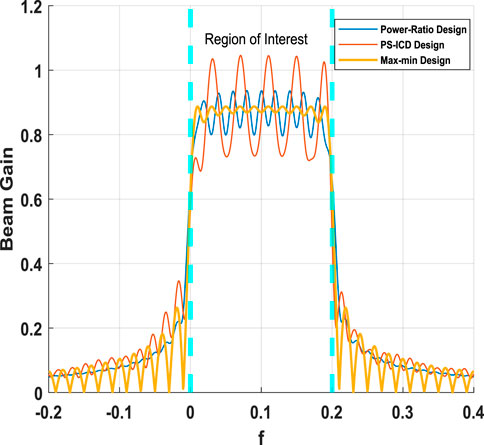
FIGURE 1. Comparison of beam patterns of two different beamformer designs against the max-min design. Here N = 10, M = 128,
Solving Eq. 26 over the set of all unimodular w can be a challenging problem, and it can be difficult to quantify and analyze the optimal solution. To make Eq. 26 tractable so that we can obtain a closed form solution with “quantifiable” minimum beamforming gain over the entire sector
Hence, b (fc, ma) represents a DFT beamformer with ma active antennas and whose pass band is centered at fc. Let
All beamformers in
Using this class
Notice that the class of beamformers
The max-min design criterion involves a natural trade-off between gain and coverage. As shown in Figure 2, when ma is large the resulting beams are sharper and can offer higher gains. Despite their higher gain, their coverage is limited owing to the narrow main lobes. Since our goal is to ensure a certain minimum gain uniformly across the entire sector
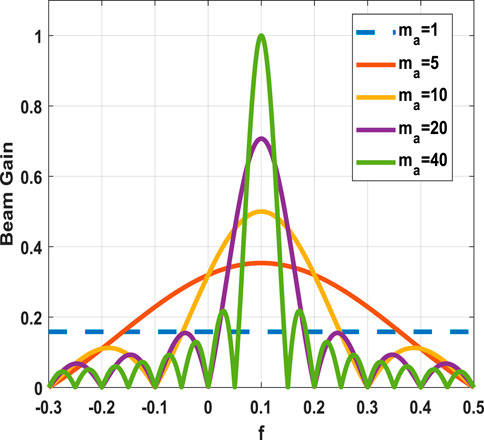
FIGURE 2. Effect of the number of active antennas on the realizable beam patterns in
Owing to the structure of
Theorem 2. Let
The optimal value is attained by the beamformer
where notation [x] refers to the closest integer to x.
Proof. The problem Eq. 28 is equivalent to the following problem
where
Fix ma. Define
The function
We first consider
Based on the definition of
Further the fact
Thus
where the inequality (a) follows from the monotonically increasing behavior of g over the interval [fc − 2/ma, fc], and Eq. 36 which implies fmin ∈ [fc − 2/ma, fc]. The inequality (b) follows from the fact that
Using a similar argument we can show that Eq. 38 also holds when fc ≤ fmid.Notice Eq. 32 implies that
Therefore, it can be easily verified that the maximum value of
which will be attained at
Optimality of
Hence as the result of Eq. 38, and Eq. 43, for any
which completes the proof.
We now develop a heuristic for N > 1 RF chains that utilizes the optimal design from Theorem 2. When N > 1, let
Similar to our prior objective, we now wish to ensure the minimum value of
Instead of exactly solving Eq. 44, we will use our design for 1 RF chain to develop a subband splitting approach for designing w1, w2, … , wN. In particular, given the interval
where
As a result of the partition (Stewart, 1990), we can adopt the optimal design obtained from Theorem 2 for each of the N problems in (Hansen, 1987). This approach greedily designs the columns of the matrix W such that the kth beamformer wk maximizes the minimum gain over
This design follows from Theorem 2, where each of the N intervals
An example of this sub-band max-min design scheme is illustrated in Figure 3, where the sector of interest
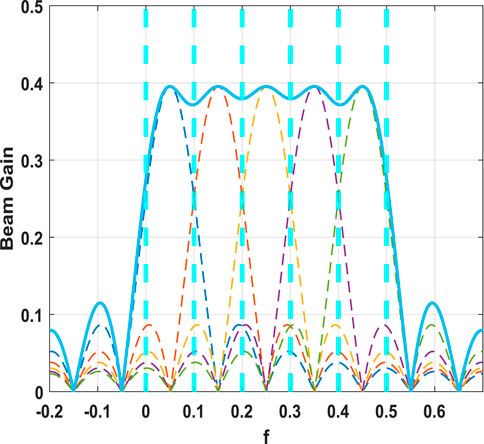
FIGURE 3. Subband splitting approach for designing N = 5 beamfomers by partitioning the region of interest into N = 5 subbands and choosing the optimal beamformer within each subband. A single RF chain is responsible for maximizing the minimum gain in each subband/partition.
In this section, we experimentally validate our analysis of beamspace ESPRIT (in Theorem 1), and also evaluate the performance of the max-min beamformer proposed in Section 2.
In the first experiment, we study the effect of varying the number (M) of antennas on the matching distance error. We fix the AOAs of the channel paths to be
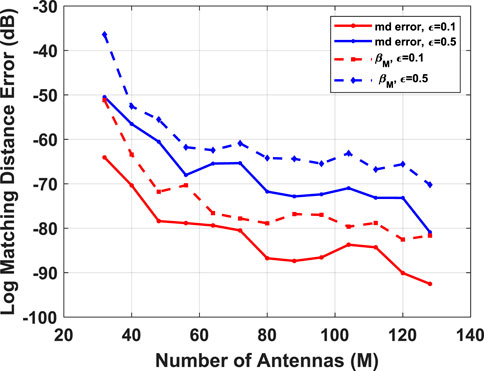
FIGURE 4. Comparative study of matching distance error as a function of the number of antennas M, using the max-min beamforming scheme for a multipath channel with S = 4 paths, N = 20 RF chains, T = 50 Snapshots. The dotted lines illustrate the trend predicted by the bounds in Theorem 1.
In order to validate the trend predicted by our theoretical result, we overlay the average βM(W, N) (averaged over the noise realizations), scaled by a factor of 10–3. As shown in Figure 4, the average matching distance error follows the trend predicted by the bound in Theorem 1. As expected, both the empirical error and the trend based on βM(W, N) increase with ϵ. The fluctuations in error (which are also consistent with the fluctuations in the bound) can be attributed to the fact that as we vary M, the gain of the beamformers at the (fixed) AoAs also fluctuate.
We now compare the proposed max-min beamformer against three other beamformer design strategies (Li et al., 2020; Chen et al., 2019) which were reviewed in Section 1. In all of the following experiments, we choose
We first generate a single LOS path with
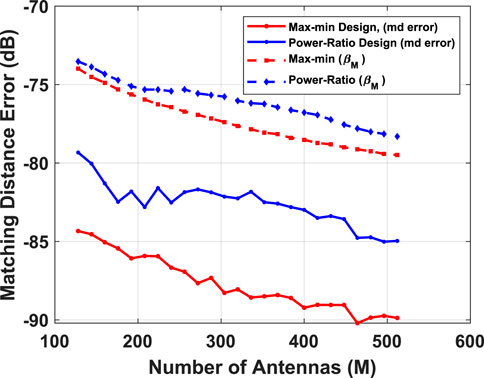
FIGURE 5. Comparative study of matching distance error as a function of the number of antennas M, using the max-min and power ratio beamforming schemes for a LOS channel with S = 1 path along
In Figures 6–12, we assume that the path gains are i. i.d random variables distributed as
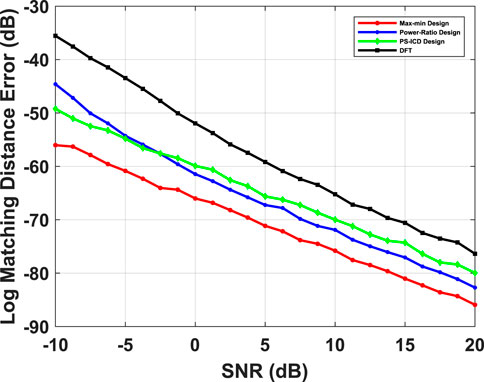
FIGURE 6. Comparison of performance of max-min beamformer against power-ratio, PS-ICD and DFT beamformers as a function of SNR, with channel path directions given by
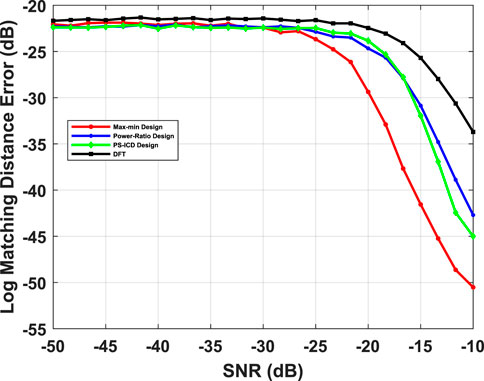
FIGURE 7. Comparison of channel estimation performance of max-min beamformer against power-ratio, PS-ICD and DFT beamformers in the SNR regime of −50 dB to −10 dB, with channel path directions given by
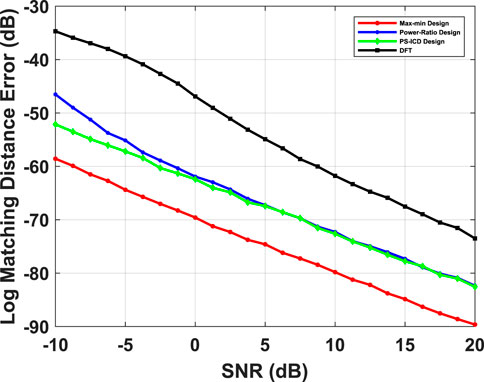
FIGURE 8. Comparison of performance of max-min beamformer against power-ratio, PS-ICD and DFT beamformers as a function of SNR, with channel path directions given by
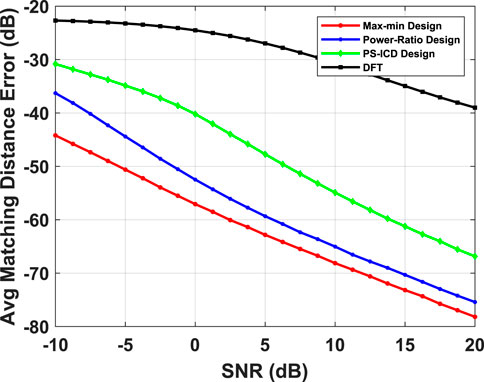
FIGURE 9. Comparison of beamspace channel estimation performance for a LOS channel with S = 1 path, M = 64 antennas, N = 5 RF chains as a function of SNR. The plot shows the matching distance error averaged over K = 100 different channel realizations by varying one of the AOAs uniformly on a grid in the region of interest.
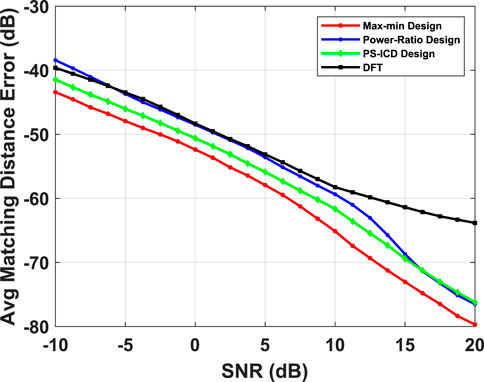
FIGURE 10. Comparison of beamspace channel estimation performance for a multipath channel with S = 4 path, M = 128 antennas, N = 10 RF chains as a function of SNR. The plot shows the matching distance error averaged over K = 100 different channel realizations by varying the one AOA uniformly on a grid in the region of interest while three other AOAs are fixed at [0.02, 0.1, 0.18].
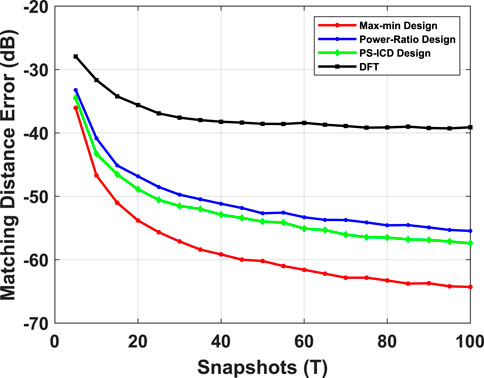
FIGURE 11. Matching distance error vs. the number of snapshots for max-min beamformer and power-ratio, PS-ICD and DFT beamformers. The channel path directions are given by
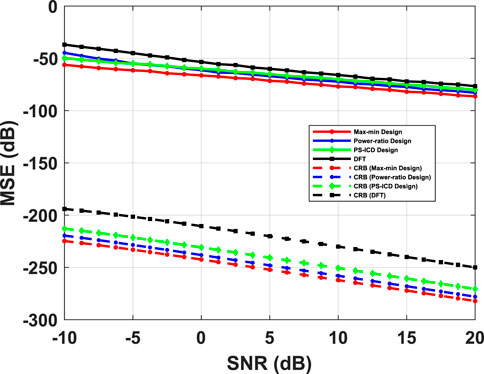
FIGURE 12. Comparative study of MSE and Cramér-Rao Bound (CRB) as a function of SNR, using the max-min and power ratio beamforming schemes for a LOS channel with S = 1 path along
In Figures 6–8, we compare the average Matching Distance error of beamspace ESPRIT as a function of SNR, using different beamformers. In Figures 6, 7, the channel is assumed to have a single LOS path, with M = 64 antennas, N = 5 RF chains, and T = 50 snapshots. In Figure 8, we consider a multi-path channel with S = 4 paths, M = 128 antennas, N = 10 RF chains, and T = 50 temporal snapshots. We considered a specific channel configuration where the AoAs are chosen from the set
In the next experiment, we investigate the performance of max-min beamformer with respect to different path directions over the region of interest. In order to do so, we choose the path angles from a uniform grid of size K = 100 over the region of interest
In Figure 9 we plot the Avg-md as a function of SNR, under a similar setting as Figure 6. In Figure 10, we repeat this for a multi-path channel, where three path directions are fixed, and the AoA of the fourth path is varied over
Owing to a higher “worst-case gain” over the region of interest, max-min beamformers enable a more robust channel estimation in face of certain (adversarial) channel configurations/multipath directions, compared to the other beamformers whose pass-band gain can drop significantly below the desired (constant) level for these directions, resulting in an overall degradation of the average error.
In Figure 11, we demonstrate the effect of the total number of temporal snapshots on the ESPRIT matching distance error for different beamforming schemes. In this experiment, we fix the SNR at −5 dB, and the other parameters are identical to those used in Figure 8. The plot shows that our schemes is effective even in the limited snapshot regime. Additionally, the gap between the performance of Min-Max design and the other beamformers steadily increases with the number of snapshots.
Finally, Figure 12 compares the MSE of beamspace ESPRIT against the beamspace Cramér-Rao Bound (CRB) for different beamformers (Van Trees, 2004), under a similar setting as Figure 6. As we can observe, the trend exhibited by the empirical MSE is consistent with the trend shown by the CRB, and the max-min beamformers exhibit a smaller CRB compared to other beamformers.
In this work, we have extended the analysis of single-snapshot ESPRIT for beamspace and multi-snapshot scenarios. Our analysis is non-asymptotic in the number of snapshots, and provides an upper bound on the matching distance error without requiring any specific distribution for the noise. The error analysis revealed the role of the beamformer design. Based on our theoretical analysis, we have proposed a novel max-min criterion for designing beamformers which ensures a minimum beamforming gain uniformly over a region of possible path directions. We have considered a family of multi-resolution beamformers which can be implemented with phase shifters, and proposed the optimal beamformers from this family with respect to the new max-min criteria. By conducting several numerical experiments, we have empirically established the superior performance of our designed beamformers compared to other beamformers. In future, an interesting question would be to extend the max-min design over a broader class of beamformers.
The raw data supporting the conclusions of this article will be made available by the authors, without undue reservation.
SS, PS, and PP developed the main conceptual idea and theoretical results presented in paper. SS, PS, and PP planned the experiments and numerical results presented in the manuscript. All authors contributed in writing the manuscript and approved the content of the submitted version.
The authors declare that the research was conducted in the absence of any commercial or financial relationships that could be construed as a potential conflict of interest.
All claims expressed in this article are solely those of the authors and do not necessarily represent those of their affiliated organizations, or those of the publisher, the editors and the reviewers. Any product that may be evaluated in this article, or claim that may be made by its manufacturer, is not guaranteed or endorsed by the publisher.
The Supplementary Material for this article can be found online at: https://www.frontiersin.org/articles/10.3389/frsip.2021.820617/full#supplementary-material
1This work was supported in part by the Office of Naval Research under Grants ONR N00014-19-1-2256 and ONR N00014-19-1-2227, and in part by the National Science Foundation under Grant NSF CAREER ECCS 1700 506.
2The results can also be extended to channels that exhibit frequency selectivity by considering orthogonal frequency-division multiplexing (OFDM), where the channel vector at each subcarrier can be described by Eq. 1.
3For multi-user system, we can reduce the problem to single-user using orthogonal pilots.
4
5
Alkhateeb, A., El Ayach, O., Leus, G., and Heath, R. W. (2014). Channel Estimation and Hybrid Precoding for Millimeter Wave Cellular Systems. IEEE J. Sel. Top. Signal. Process. 8 (5), 831–846. doi:10.1109/jstsp.2014.2334278
Alkhateeb, A., and Heath, R. W. (2016). Frequency Selective Hybrid Precoding for Limited Feedback Millimeter Wave Systems. IEEE Trans. Commun. 64 (5), 1801–1818. doi:10.1109/tcomm.2016.2549517
Alkhateeb, A., Mo, J., Gonzalez-Prelcic, N., and Heath, R. W. (2014). Mimo Precoding and Combining Solutions for Millimeter-Wave Systems. IEEE Commun. Mag. 52 (12), 122–131. doi:10.1109/mcom.2014.6979963
Ayach, O. E., Rajagopal, S., Abu-Surra, S., Pi, Z., and Heath, R. W. (2014). Spatially Sparse Precoding in Millimeter Wave Mimo Systems. IEEE Trans. Wireless Commun. 13 (3), 1499–1513. doi:10.1109/twc.2014.011714.130846
Bai, T., and Heath, R. W. (2014). Coverage and Rate Analysis for Millimeter-Wave Cellular Networks. IEEE Trans. Wireless Commun. 14 (2), 1100–1114.
Bauer, F. L., and Fike, C. T. (1960). Norms and Exclusion Theorems. Numer. Math. 2 (1), 137–141. doi:10.1007/bf01386217
Bogale, T. E., Le, L. B., and Wang, X. (2015). Hybrid Analog-Digital Channel Estimation and Beamforming: Training-Throughput Tradeoff. IEEE Trans. Commun. 63 (12), 5235–5249. doi:10.1109/tcomm.2015.2495191
Chen, K., and Qi, C. (2018). “Beam Design with Quantized Phase Shifters for Millimeter Wave Massive Mimo,” in 2018 IEEE Global Communications Conference (GLOBECOM) (IEEE), 1–7. doi:10.1109/glocom.2018.8647641
Chen, K., Qi, C., and Li, G. Y. (2019). Two-step Codeword Design for Millimeter Wave Massive Mimo Systems with Quantized Phase Shifters. IEEE Trans. Signal Process. 68, 170–180.
Chiu, S.-E., Ronquillo, N., and Javidi, T. (2019). Active Learning and Csi Acquisition for Mmwave Initial Alignment. IEEE J. Select. Areas Commun. 37 (11), 2474–2489. doi:10.1109/jsac.2019.2933967
Gao, Z., Hu, C., Dai, L., and Wang, Z. (2016). Channel Estimation for Millimeter-Wave Massive Mimo with Hybrid Precoding over Frequency-Selective Fading Channels. IEEE Commun. Lett. 20 (6), 1259–1262. doi:10.1109/lcomm.2016.2555299
González-Coma, J. P., Rodriguez-Fernandez, J., González-Prelcic, N., Castedo, L., and Heath, R. W. (2018). Channel Estimation and Hybrid Precoding for Frequency Selective Multiuser Mmwave Mimo Systems. IEEE J. Sel. Top. Signal. Process. 12 (2), 353–367. doi:10.1109/jstsp.2018.2819130
Guanghan Xu, G., Silverstein, S. D., Roy, R. H., and Kailath, T. (1994). Beamspace Esprit. IEEE Trans. Signal. Process. 42 (2), 349–356. doi:10.1109/78.275607
Guo, Z., Wang, X., and Heng, W. (2017). Millimeter-wave Channel Estimation Based on 2-d Beamspace Music Method. IEEE Trans. Wireless Commun. 16 (8), 5384–5394. doi:10.1109/twc.2017.2710049
Haardt, M., and Nossek, J. A. (1995). Unitary Esprit: How to Obtain Increased Estimation Accuracy with a Reduced Computational burden. IEEE Trans. Signal. Process. 43 (5), 1232–1242. doi:10.1109/78.382406
Haghighatshoar, S., and Caire, G. (2016). Massive Mimo Channel Subspace Estimation from Low-Dimensional Projections. IEEE Trans. Signal Process. 65 (2), 303–318.
Han, S., I, C.-l., Xu, Z., and Rowell, C. (2015). Large-scale Antenna Systems with Hybrid Analog and Digital Beamforming for Millimeter Wave 5g. IEEE Commun. Mag. 53 (1), 186–194. doi:10.1109/mcom.2015.7010533
Hansen, P. C. (1987). The Truncatedsvd as a Method for Regularization. Bit 27 (4), 534–553. doi:10.1007/bf01937276
Hur, S., Kim, T., Love, D. J., Krogmeier, J. V., Thomas, T. A., and Ghosh, A. (2013). Millimeter Wave Beamforming for Wireless Backhaul and Access in Small Cell Networks. IEEE Trans. Commun. 61 (10), 4391–4403. doi:10.1109/tcomm.2013.090513.120848
Junyi Wang, J., Zhou Lan, Z., Chang-woo Pyo, C.-w., Baykas, T., Chin-sean Sum, C.-s., Rahman, M. A., et al. (2009). Beam Codebook Based Beamforming Protocol for Multi-Gbps Millimeter-Wave Wpan Systems. IEEE J. Select. Areas Commun. 27 (8), 1390–1399. doi:10.1109/jsac.2009.091009
Lee, J., Gil, G.-T., and Lee, Y. H. (2016). Channel Estimation via Orthogonal Matching Pursuit for Hybrid Mimo Systems in Millimeter Wave Communications. IEEE Trans. Commun. 64 (6), 2370–2386. doi:10.1109/tcomm.2016.2557791
Li, W., Liao, W., and Fannjiang, A. (2020). Super-resolution Limit of the Esprit Algorithm. IEEE Trans. Inform. Theor. 66 (7), 4593–4608. doi:10.1109/tit.2020.2974174
Liao, A., Gao, Z., Wu, Y., Wang, H., and Alouini, M.-S. (2017). 2d Unitary Esprit Based Super-resolution Channel Estimation for Millimeter-Wave Massive Mimo with Hybrid Precoding. IEEE Access 5, 24747–24757. doi:10.1109/access.2017.2768579
Ma, W., Qi, C., and Li, G. Y. (2020). High-resolution Channel Estimation for Frequency-Selective Mmwave Massive Mimo Systems. IEEE Trans. Wireless Commun. 19 (5), 3517–3529. doi:10.1109/twc.2020.2974728
Mathews, C. P., Haardt, M., and Zoltowski, M. D. (1996). Performance Analysis of Closed-form, Esprit Based 2-d Angle Estimator for Rectangular Arrays. IEEE Signal. Process. Lett. 3 (4), 124–126. doi:10.1109/97.489068
Méndez-Rial, R., Rusu, C., González-Prelcic, N., Alkhateeb, A., and Heath, R. W. (2016). Hybrid MIMO Architectures for Millimeter Wave Communications: Phase Shifters or Switches. Ieee Access 4, 247–267. doi:10.1109/access.2015.2514261
Park, S., Ali, A., González-Prelcic, N., and Heath, R. W. (2019). Spatial Channel Covariance Estimation for Hybrid Architectures Based on Tensor Decompositions. IEEE Trans. Wireless Commun. 19 (2), 1084–1097.
Park, S., and Heath, R. W. (2018). Spatial Channel Covariance Estimation for the Hybrid Mimo Architecture: A Compressive Sensing-Based Approach. IEEE Trans. Wireless Commun. 17 (12), 8047–8062. doi:10.1109/twc.2018.2873592
Raghavan, V., and Sayeed, A. M. (2010). Sublinear Capacity Scaling Laws for Sparse Mimo Channels. IEEE Trans. Inf. Theor. 57 (1), 345–364.
Rakhimov, D., Zhang, J., de Almeida, A., Nadeev, A., and Haardt, M. (2019). “Channel Estimation for Hybrid Multi-Carrier Mmwave Mimo Systems Using 3-d Unitary Tensor-Esprit in Dft Beamspace,” in 2019 53rd Asilomar Conference on Signals, Systems, and Computers (IEEE), 447–451. doi:10.1109/ieeeconf44664.2019.9048951
Rodríguez-Fernández, J., González-Prelcic, N., Venugopal, K., and Heath, R. W. (2018). Frequency-domain Compressive Channel Estimation for Frequency-Selective Hybrid Millimeter Wave Mimo Systems. IEEE Trans. Wireless Commun. 17 (5), 2946–2960. doi:10.1109/twc.2018.2804943
Roemer, F., Haardt, M., and Del Galdo, G. (2014). Analytical Performance Assessment of Multi-Dimensional Matrix-And Tensor-Based Esprit-type Algorithms. IEEE Trans. Signal Process. 62 (10), 2611–2625.
Roh, W., Seol, J.-Y., Park, J., Lee, B., Lee, J., Kim, Y., et al. (2014). Millimeter-wave Beamforming as an Enabling Technology for 5g Cellular Communications: Theoretical Feasibility and Prototype Results. IEEE Commun. Mag. 52 (2), 106–113. doi:10.1109/mcom.2014.6736750
Roy, R., and Kailath, T. (1989). Esprit-estimation of Signal Parameters via Rotational Invariance Techniques. IEEE Trans. Acoust. Speech, Signal. Process. 37 (7), 984–995. doi:10.1109/29.32276
Sarangi, P., Shahsavari, S., and Pal, P. (2020). “Robust Doa and Subspace Estimation for Hybrid Channel Sensing,” in 2020 54th Asilomar Conference on Signals, Systems, and Computers (IEEE), 236–240. doi:10.1109/ieeeconf51394.2020.9443309
Schmidt, R. (1986). Multiple Emitter Location and Signal Parameter Estimation. IEEE Trans. Antennas Propagat. 34 (3), 276–280. doi:10.1109/tap.1986.1143830
Steinwandt, J., Roemer, F., Haardt, M., and Galdo, G. D. (2017). Performance Analysis of Multi-Dimensional Esprit-type Algorithms for Arbitrary and Strictly Non-circular Sources with Spatial Smoothing. IEEE Trans. Signal. Process. 65 (9), 2262–2276. doi:10.1109/tsp.2017.2652388
Van Trees, H. L. (2004). Optimum Array Processing: Part IV of Detection, Estimation, and Modulation Theory. John Wiley & Sons.
Venugopal, K., Alkhateeb, A., Heath, R. W., and Prelcic, N. G. (2017). ““Time-domain Channel Estimation for Wideband Millimeter Wave Systems with Hybrid Architecture,” in 2017 IEEE International Conference on Acoustics, Speech and Signal Processing (ICASSP) (IEEE), 6493–6497. doi:10.1109/icassp.2017.7953407
Wedin, P. Å. (1972). Perturbation Bounds in Connection with Singular Value Decomposition. Bit 12 (1), 99–111. doi:10.1007/bf01932678
Wen, F., Garcia, N., Kulmer, J., Witrisal, K., and Wymeersch, H. (2018). “Tensor Decomposition Based Beamspace Esprit for Millimeter Wave Mimo Channel Estimation,” in 2018 IEEE Global Communications Conference (GLOBECOM) (IEEE), 1–7. doi:10.1109/glocom.2018.8647176
Yu, X., Shen, J.-C., Zhang, J., and Letaief, K. B. (2016). Alternating Minimization Algorithms for Hybrid Precoding in Millimeter Wave Mimo Systems. IEEE J. Sel. Top. Signal. Process. 10 (3), 485–500. doi:10.1109/jstsp.2016.2523903
Zhang, J., and Haardt, M. (2017). “Channel Estimation for Hybrid Multi-Carrier Mmwave Mimo Systems Using Three-Dimensional Unitary Esprit in Dft Beamspace,” in 2017 IEEE 7th International Workshop on Computational Advances in Multi-Sensor Adaptive Processing (CAMSAP) (IEEE), 1–5. doi:10.1109/camsap.2017.8313174
Zhang, J., Rakhimov, D., and Haardt, M. (2021). Gridless Channel Estimation for Hybrid Mmwave Mimo Systems via Tensor-Esprit Algorithms in Dft Beamspace. IEEE J. Sel. Top. Signal. Process. 15 (3), 816–831. doi:10.1109/jstsp.2021.3063908
Zoltowski, M. D., Haardt, M., and Mathews, C. P. (1996). Closed-form 2-d Angle Estimation with Rectangular Arrays in Element Space or Beamspace via Unitary Esprit. IEEE Trans. Signal. Process. 44 (2), 316–328. doi:10.1109/78.485927
Our proof follows similar arguments as [1] with necessary modifications for beamspace and multi-snapshot scenario. For completeness, we provide all auxiliary lemmas used.
Preliminaries
Let S1, S2 be any orthonormal bases for
We consider the SVD of
Here we assumed that the singular vectors are ordered such that ω1 ≥ ω2 ≥…, ≥ ωS. We also denote
The augmented noise matrix is given by:
where
where the first inequality follows from the fact that
For any matrix F, we adopt the notation σmax(F)≔‖F‖2, and σmin(F)≔1/‖F†‖2. We first use Wedin’s theorem [2] to bound
Lemma 1. (Wedin’s Theorem [2]). Consider matrices
Consider the Singular Value Decompositions of A and B:
where
Lemma 2. Consider the matrices A, B1, U1, V1 defined in Lemma 1. If rank(A) = L, and ‖N‖2 ≤ σL(A)/2, the following holds
Proof. Note that since rank(A) = L, we have A0 = 0, and σmin(A) = σL(A). Using Weyl’s theorem [3] for matrix perturbation, we can write
where the last inequality follows from the assumption ‖N‖2 ≤ σL(A)/2. The conditions of Lemma 1 are satisfied with α = 0 and δ = σL(A) completing the proof of Lemma 2. □We will also be using the following standard result from [4, Pg. 36].
Lemma 3. For any matrices
Lemma 4. Let
Proof. When the noise
Using the fact ‖Vy‖2 = 1, ‖Uy‖2 = 1, we have
Now, under the canonical basis assumption, we have
Therefore,
The proof is completed by combining (52) and (51). □
Lemma 5. Consider the measurement model in (14). If rank(BX) = S, and
Proof. Notice that
where the last inequality follows from the fact that
We use a result from [5, Theorem 3.2] which states that a matrix F with rank S, and its perturbed matrix
provided the perturbation satisfies ‖E‖2 < σS(F). We use this result by substituting F with U, and
Therefore, we have that
Lemma 6. Consider the measurement model in (14) such that (17) holds. Then the following bound is satisfied:
Proof. From (17) and (49), we have
where the second inequality follows from the fact that σS(U1) ≤ 1 and S ≥ 1. By applying Lemma 4, (50) holds. Now, (50) and (58) together imply that
Lemma 7.
Proof. The proof follows directly from eq. (III.1) in [1] □
Lemma 8. Consider the measurement model in (14). If rank(BX) = S, then
Proof. Based on (9), Ψ is diagonalizable by the invertible matrix P. Using Bauer-Fike theorem, [6], [4, Theorem 3.3] and Lemma 7, we have
where κ(P−1) = ‖P‖2‖P−1‖2. To bound κ(P−1), we use the fact that Uy = BP and ‖Uy‖2 = 1. This implies that
References
[1] W. Li, W. Liao, and A. Fannjiang, “Super-resolution limit of the esprit algorithm,” IEEE Transactions on Information Theory, vol. 66, no. 7, pp. 4593–4608, 2020.
[2] P.-A. Wedin, “Perturbation bounds in connection with singular value decomposition,” BIT Numerical Mathematics, vol. 12, no. 1, pp. 99–111, 1972.
[3] J. N. Franklin, Matrix theory. Courier Corporation, 2012.
[4] G. W. Stewart, “Matrix perturbation theory,” 1990.
[5] P. C. Hansen, “The truncatedsvd as a method for regularization,” BIT Numerical Mathematics, vol. 27, no. 4, pp. 534–553, 1987.
[6] F. L. Bauer and C. T. Fike, “Norms and exclusion theorems,” Numerische Mathematik, vol. 2, no. 1, pp. 137–141, 1960.
Keywords: millimeter wave, beamspace ESPRIT, massive MIMO, channel estimation, beamformer design
Citation: Shahsavari S, Sarangi P and Pal P (2022) Beamspace ESPRIT for mmWave Channel Sensing: Performance Analysis and Beamformer Design. Front. Sig. Proc. 1:820617. doi: 10.3389/frsip.2021.820617
Received: 23 November 2021; Accepted: 31 December 2021;
Published: 11 February 2022.
Edited by:
Maria Sabrina Greco, University of Pisa, ItalyCopyright © 2022 Shahsavari, Sarangi and Pal. This is an open-access article distributed under the terms of the Creative Commons Attribution License (CC BY). The use, distribution or reproduction in other forums is permitted, provided the original author(s) and the copyright owner(s) are credited and that the original publication in this journal is cited, in accordance with accepted academic practice. No use, distribution or reproduction is permitted which does not comply with these terms.
*Correspondence: Piya Pal, pipal@eng.ucsd.edu
Disclaimer: All claims expressed in this article are solely those of the authors and do not necessarily represent those of their affiliated organizations, or those of the publisher, the editors and the reviewers. Any product that may be evaluated in this article or claim that may be made by its manufacturer is not guaranteed or endorsed by the publisher.
Research integrity at Frontiers

Learn more about the work of our research integrity team to safeguard the quality of each article we publish.